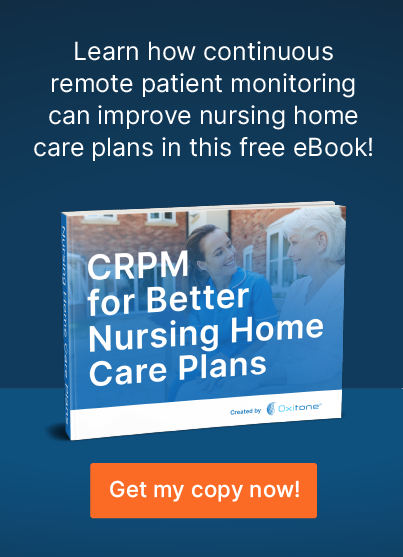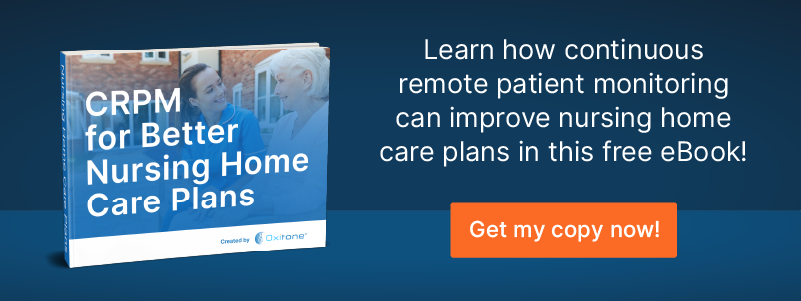Nursing homes are an essential stop for many post-acute patients before they are ready to go home. Similarly, multiple chronic patients receive better care at such facilities. A continuous remote patient monitoring (CRPM) system can be an excellent addition to any nursing home care planning setup because of its advanced capabilities.
Nursing Home Care Planning with CRPM
Skilled nursing facilities are an integral part of managing a significant portion of chronic and post-acute patients. Remote patient monitoring (RPM) has proven to be a gamechanger for such facilities, and many nursing homes are using it in some capacity. CRPM can further enhance those advantages. With CRPM, nursing home care planning can include early detection, greater insights into disease progression, reduced readmission rates, and higher overall patient satisfaction.
Let’s take a detailed look at how CRPM can improve patient care in skilled nursing facilities.
1. Assist in early intervention
The most frequent users of nursing homes are patients with chronic diseases. Their conditions may exacerbate over time and create medication emergencies. But most of these emergencies create plenty of symptoms beforehand. CRPM with AI-based predictive analytics can cover for many acute conditions before they become an issue. Through a proactive approach, doctors can prevent most emergencies and ER visits.
Moreover, healthcare emergencies are usually time sensitive. With CRPM, all essential parameters are monitored to detect symptoms and notify the hospital for immediate and timely intervention.
2. Reduction in readmission rates
With the world shifting toward value-based healthcare systems, reducing hospital readmission rates has become even more essential. Today, hospitals are incentivized to find and minimize the risk of readmission by improving post-acute care and keeping a proactive approach to healthcare.
This preemptive approach can’t only be facilitated with the nursing staff; instead, it also has to be implemented by the patient in their lives. CRPM provides patients with the tools that they need to engage with their health. It can also help staff educate patients, enhance compliance, and improve the overall care that they receive. The result is a natural reduction in hospital readmission rates.
3. Insights about disease progression and patient recovery
Traditional means of monitoring patient progress lack the comprehensiveness of CRPM. They prevent doctors from noticing any patterns to accurately track the decline or progress of any condition. CRPM provides a medium through which doctors and nursing homes can access unprecedented levels of data to closely monitor patients.
Integrating CRPM in any nursing home care plan will help medical professionals better understand diseases and recovery. It’s through an extensive understanding of a standard patient’s progress that healthcare workers can monitor, observe and identify general trends to improve their services.
4. Enhanced patient satisfaction
If you ask an average chronic patient about their worst fears, they would probably name long-term hospitalizations and high-cost intensive care units. CRPM helps them avoid just that.
With CRPM, chronic patients can enjoy increased independence and self-reliance without fear of sudden emergencies or delayed intervention during flare-ups. The tight management and monitoring system can help immediately identify any new developments and inform caregivers for intervention.
The best part is that it doesn’t hinder regular life. The patient doesn’t have to be strapped into an intricate contraption that limits movement. CRPM devices use bio-sensors in the shape of everyday devices, like a watch. This allows patients to go about their day as normal, without any inconvenience.
CRPM increases overall efficiency and enables healthcare workers to actively engage with patients. Moreover, the saved time and effort can be better spent on more severe and critical cases that require more focus and attention.
The drastic improvement in the quality of life for patients and more efficient nursing staff can lead to more satisfied patients.
5. Multiparameter monitoring from a single device
When it comes to chronic diseases, there are multiple variables of concern that healthcare workers need to monitor to make informed judgments about the patient’s current status and progress. RPM kits usually include multiple devices that monitor certain parameters individually.
This isn’t the case with CRPM. It’s a hassle-free system that usually integrates into a single device that is capable of continually capturing and analyzing essential data related to several health parameters. These parameters can include skin temperature, blood oxygen level, sleep patterns, and more.
CRPM with Oxitone: Innovative, Efficient, Effective!
Many nursing homes and healthcare facilities have shifted their operations to RPM. The benefits of this approach are increasingly becoming evident with each day. That said, CRPM is the more comprehensive alternative because it covers most of RPM’s weaknesses and has several additional benefits for all stakeholders.
CRPM manages to address and counter several blind spots and shortcomings of RPM. The technology is still in development, but with time, it will be able to provide equal or more effective services to patients, at a fraction of the cost.
Oxitone is a state-of-the-art CRPM solution that can be fully integrated within a healthcare system that enables healthcare workers to capture, analyze information, and use predictive trends based on real-time data. Intelligent and timely insights by Oxitone can drastically change the game for high-risk patients and enable a level of healthcare that previously wasn’t possible cost-effectively.
Here at Oxitone, we boost value-based healthcare by delivering extraordinary patient, clinical, and economical outcomes at reduced medical utilization and cost. Patients need a prompt response to emergencies. Physicians need an easy and timely follow-up with patients. Our mission is to transform chronic disease management and help save lives worldwide.
Let’s save lives together! To see how we help remote patient monitoring companies and physicians improve the management and care of high-risk patients, contact us today!


